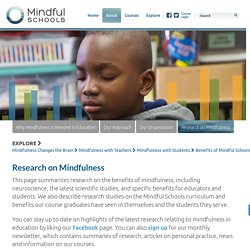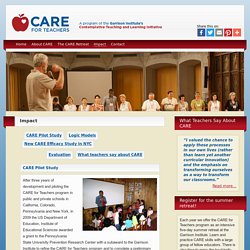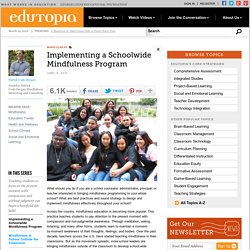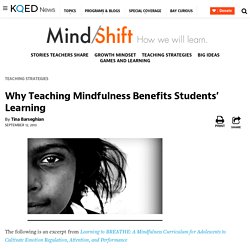

IMG 3626. Mindfulness research from studies, educators, schools, surveys. 1 Chiesa, A., & Serretti, A. (2009).

Mindfulness-based stress reduction for stress management in healthy people: a review and meta-analysis. The Journal of Alternative and Complementary Medicine, 15(5), 593–600. Sedlmeier, P., Eberth, J., Schwarz, M., Zimmermann, D., Haarig, F., Jaeger, S., & Kunze, S. (2012). The psychological effects of meditation: A meta-analysis. Psychological Bulletin, 138(6), 1139. Research/Evidence on Mindfulness for Young People in general - Mindfulness In Schools. Research Round-Up: Mindfulness in Schools.
The last decade has seen a huge spike in secular applications of mindfulness, the practice of focusing our attention on our thoughts, feelings, and environment in the present moment.

While the first wave of mindfulness-based programs were for adults, more recent efforts have targeted the well-being of children and adolescents; as a result, mindfulness programs in schools are becoming more and more widespread. But until recently, “enthusiasm for promoting such practices [outweighed] the current evidence supporting them,” to quote a 2012 review of the research on mindfulness practices with children and youth. That has changed in the past year with a spate of new studies: Researchers have been aggressively testing the effectiveness of school-based mindfulness programs, and they are starting to publish their results. Here is a round-up of studies published just within the last few months. 1) Black, D. A student participating in the Mindful Schools program.Mindful Schools What did they study?
Impact - CARE for Teachers. CARE Pilot Study After three years of development and piloting the CARE for Teachers program in public and private schools in California, Colorado, Pennsylvania and New York, in 2009 the US Department of Education, Institute of Educational Sciences awarded a grant to the Pennsylvania State University Prevention Research Center with a subaward to the Garrison Institute to refine the CARE for Teachers program and to complete a preliminary pilot study of its efficacy in reducing teacher stress and improving teacher well-being, efficacy and mindfulness.

(IES grant #R305A090179). Results suggest that CARE is a promising tool to help teachers create and maintain a positive classroom learning environment, avoid burnout and attrition, and enjoy and excel in their work. The research team found significant improvements in well-being, efficacy, and mindfulness among teachers who participated in the CARE program compared to the control group.
CARE AERA Presentation 2012.pdf Recent Publications Top Top. Implementing a School-Wide Mindfulness Program. What should you do if you are a school counselor, administrator, principal, or teacher interested in bringing mindfulness programming to your whole school?

What are best practices and sound strategy to design and implement mindfulness effectively throughout your school? Across the country, mindfulness education is becoming more popular. This practice teaches students to pay attention to the present moment with compassion and non-judgmental awareness. Through meditation, eating, listening, and many other forms, students learn to maintain a moment-by-moment awareness of their thoughts, feelings, and bodies.
Over the past decade, teachers across the U.S. have started teaching mindfulness in their classrooms. A quick warning: There is no "one model" out there. Pre-Launch 1. It will take a few years to develop a school-wide mindfulness program. 2. Finding time in your school day may be your biggest challenge. 3. Are you trying to reduce stress? Faculty 4. 5. Why Teaching Mindfulness Benefits Students’ Learning. The following is an excerpt from Learning to BREATHE: A Mindfulness Curriculum for Adolescents to Cultivate Emotion Regulation, Attention, and Performance By Patricia C.

Broderick, PhD What do children and adolescents need to be successful in life? When this question arises, a common answer is “a good education.” Academic success is the goal that is emphasized in standards-based movements about education reform, and it is currently in the forefront of public consciousness. There is little doubt that in addition to academic success, we also want our youth to be happy and well. These goals are far from being disconnected: we now realize the fundamental role that social and emotional well-being play in the attainment of academic outcomes.
Although the emphasis on academic achievement often captures most of the attention in debates on school reform, important inroads are being made by those who take a more holistic approach to education. [RELATED: The Importance of Teaching Mindfuless] 1.